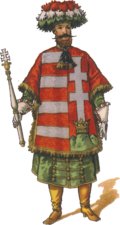Coat of arms of Hungary
The coat of arms of Hungary was adopted on 3 July 1990,[1] after the end of the communist rule, although it has been used before, both with and without the Holy Crown of Hungary, sometimes as part of a larger, more complex coat of arms, and many of its elements date back to the Middle Ages. It has four red and white stripes. Traditionally, the silver stripes represent four rivers: Duna (Danube), Tisza, Dráva, and Száva.[2] It is an white double cross on a red shield, inside a small golden crown, the crown is on the middle heap of three green hills, representing the mountain ranges Tatra, Mátra, and Fátra (made up of the Veľká Fatra and Malá Fatra ranges).[3]
Coat Of Arms Of Hungary Media
Arms of Hungary on the 1890 Austro-Hungarian florin coin; the right version adds the arms of Fiume
Royal herald wearing tabard with the arms of Hungary in the 1899 book Heraldischer Atlas
Coat of Arms at Liberty Bridge in Budapest
Related pages
References
- ↑ "1990. évi XLIV. törvény a Magyar Köztársaság Alkotmányának módosításáról" [Act XLIV of 1990 on the Amendment of the Constitution of the Hungarian Republic]. hu.wikisource.org (in magyar). Retrieved 12 February 2017.
- ↑ Betsy Dru Tecco: How to Draw Hungary's Sights and Symbols, The Rosen Publishing Group, New York, 2005 [1]
- ↑ Betsy Dru Tecco: How to Draw Hungary's Sights and Symbols, The Rosen Publishing Group, New York, 2005 [2]









